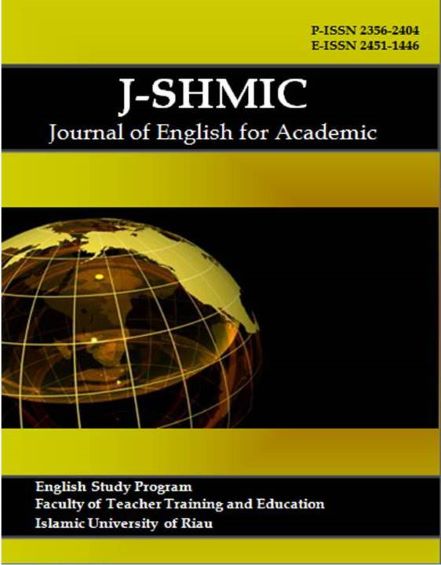Initial Activities Encouraging Students’ Autonomous Learning: Faculty Teacher Training and Education Program
Keywords:
Initial activities, Encouraging, Autonomous LearningAbstract
Initial activities become important as the stepstone to raise students’ autonomous level. The study aims to explore lecturers’ initial activities to encourage students’ autonomous learning. Autonomous learning is a process to be apprehensive of taking control of literacy. This study used a case study and a content analysis in the qualitative exploration. The English teacher educators at the English language education department, the faculty of teacher training and education in Pekanbaru became the research samples. A qualitative approach is chosen as exploration design with the help of Nvivo 12 Apps since interviews come as the main instrument. Some interview points questioned how lecturers help learners comprehend the material, determine their particular pretensions, chancing out supporting coffers. The study reveals that the lecturer's exertion as the initial activities were giving the material explanation, giving information about the course figure, giving assignments, giving what students need, giving provocation or motivation, sharing experiences, making personal approach, exercising, being a Model, making agreement letter, warning, having a concession, having references of material, participating gests, checking students’ appreciation by reviewing, giving question and test. Yet, giving assignments collectively or in collaboration, systems or incidental test becomes a proposed exertion in the initial process to enhance learners’ autonomous.
Downloads
References
Agustín-Llach, M. P., & Canga Alonso, A. (2017). Fostering learner autonomy through vocabulary strategy training. Second Language Learning and Teaching, 141–158. https://doi.org/10.1007/978-3-319-07764-2_9
Al Asmari, A. R. (2013). Practices and prospects of learner autonomy: Teachers’ perceptions. English Language Teaching, 6(3), 1–11. https://doi.org/10.5539/elt.v6n3p1
Balcıkanli, C. (2010). Learner autonomy in language learning: student teachers’ beliefs (Vol. 35, Issue 1).
Barrett, A. M., Chawla-Duggan, R., Lowe, J., Nikel, J., & Ukpo, E. (2006). The Concept of Quality in Education: A Review of The ‘International’ Literature on The Concept of Quality in Education. EdQual Working Paper, 3(3), 23.
Benson, P. (2008). Teachers’ and learners’ perspectives on autonomy. https://doi.org/10.1075/aals.1.05ben
Brown, A., & Ruiz, H. (2017). Equity and enrichment in the TESOL practicum. ELT Journal, 71(3), 284–294. https://doi.org/10.1093/elt/ccw092
ÇAKICI, D. (2015). Autonomy in {Language} {Teaching} and {Learning} {Process}. İnönü Üniversitesi Eğitim Fakültesi Dergisi, 16(1). https://doi.org/10.17679/iuefd.16168538
Cilliers, E. J. (2017). the Challenge of Teaching Generation Z. PEOPLE: International Journal of Social Sciences, 3(1), 188–198. https://doi.org/10.20319/pijss.2017.31.188198
Dang, T. T. (2012). Learner Autonomy Perception and Performance: A Study on Vietnamese Students.
Espinosa, A. R. (2015). Fostering {Autonomy} {Through} {Syllabus} {Design}: {A} {Step}-by-{Step} {Guide} for {Success} * {El} fomento de la autonomía a través del diseño del sílabo: una guía paso a paso hacia el éxito ** (Issue 2).
Gao, X. (Andy). (2011). Language learner autonomy: policy, curriculum, classroom. Journal of Multilingual and Multicultural Development, 32(1), 97–99. https://doi.org/10.1080/01434632.2010.515719
Govender, S., & Ajani, O. A. (2021). Monitoring and Evaluation of Teacher Professional Development for Resourceful Classroom Practices. 9(4), 870–879. https://doi.org/10.13189/ujer.2021.090421
Guo, Y. (2018). The Influence of Academic Autonomous Motivation on Learning Engagement and Life Satisfaction in Adolescents: The Mediating Role of Basic Psychological Needs Satisfaction. Journal of Education and Learning, 7(4), 254. https://doi.org/10.5539/jel.v7n4p254
Hafner, C. A., & Miller, L. (2011). Hafnermiller. 15(3), 68–86.
Javad Riasati, M., & Mollaei, F. (2014). Teachers’ and Learners’ Attitudes Towards Applying Autonomous Learning in Language Classrooms. International Journal of Language Learning and Applied Linguistics World, 6(188), 188–201.
Khotimah, K., Widiati, U., Mustofa, M., & Faruq Ubaidillah, M. (2019). Autonomous English learning: Teachers’ and students’ perceptions. Indonesian Journal of Applied Linguistics, 9(2), 371–381. https://doi.org/10.17509/ijal.v9i2.20234
Khulaifiyah, Utami Widiati, Mirjam Anugerahwati, N. S. (2021). Autonomous Learning Activities: The Perceptions of English Language Students in Indonesia. Pegem Journal of Education and Instruction, 11(3), 34–49. https://doi.org/10.14527/pegegog.2021.00
Klimas, A. (2017). A goal-setting logbook as an instrument fostering learner autonomy. Second Language Learning and Teaching, 21–33. https://doi.org/10.1007/978-3-319-07764-2_2
Lengkanawati, N. S. (2017). Learner autonomy in the indonesian efl settings. Indonesian Journal of Applied Linguistics. https://doi.org/10.17509/ijal.v6i2.4847
Masouleh, N. S., & Jooneghani, R. B. (2012). Autonomous learning: A teacher-less learning! Procedia - Social and Behavioral Sciences, 55, 835–842. https://doi.org/10.1016/j.sbspro.2012.09.570
Murphy, L. (2007). Supporting learner autonomy: theory and practice in a distance learning context. Learner Autonomy 10: Integration and Support., 72–92.
Myartawan, I. P. N. W., Latief, M. A., & Suharmanto, S. (2013). The correlation between learner autonomy and {English} proficiency of {Indonesian} {EFL} college learners. Teflin Journal, 24(1), 63–81.
Nguyen, N. T. (2011). Syllabus Negotiation: A Case Study in a Tertiary EFL Context in Vietnam. Language Education in Asia, 2(1), 71–91. https://doi.org/10.5746/leia/11/v2/i1/a06/nguyen
Nhan, N. T., & Lai, H. T. (2012). The Enhancement of Learner Autonomy and the Growth of English Language Proficiency. Language in India, 12(4), 436–448. http://search.proquest.com/docview/1315888181?accountid=14548
Phan, T. T. T. (2013). Teacher {Autonomy} and {Learner} {Autonomy}: {An} {East} {Asian}’s {Perspective}. International Journal of Social Science and Humanity, 2(6), 468–471. https://doi.org/10.7763/ijssh.2012.v2.149
Scharle, A., & Szabó, A. (2000). Learner autonomy : a guide to developing learner responsibility. 112.
Smith, R. C. (2000). Learner autonomy, teacher autonomy: Future directions. Starting with Ourselves: Teacher-Learner Autonomy in Language Learning, Benson 2000, 89–99.
Studies, L., & Solmaz, O. (2017). Autonomous language learning on Twitter: Performing affiliation with target language users through #hashtags. Dil ve Dilbilimi Çalışmaları Dergisi, 13(2), 204–220.
Suharmanto. (2003). Learning autonomy : A way to improve English language teaching. TEFLIN Journal, 14(1). https://doi.org/http://dx.doi.org/10.15639/teflinjournal.v14i1/111-122
Tholin, J., & Smith, R. (2008). Learner autonomy, self-directed learning and assessment: lessons from Swedish experience. Independence, 43. http://hdl.handle.net/2320/3572
Vázquez, B. M. (2016). Learner autonomy as a defensible educational goal in modern language education. Journal of English and Spanish Studies, 1(1), 90–106.
Vlachopoulos, D., & Makri, A. (2017). The effect of games and simulations on higher education: a systematic literature review. In International Journal of Educational Technology in Higher Education (Vol. 14, Issue 1). International Journal of Educational Technology in Higher Education. https://doi.org/10.1186/s41239-017-0062-1
Warman, L. A. D. (2021). The Effect of Google Classroom in Blended Learning on University Students’ English Ability. J-SHMIC : Journal of English for Academic, 8(1), 12–23. https://doi.org/10.25299/jshmic.2021.vol8(1).6216
Yim, J., & Chuk, P. (2004). Promoting learner autonomy in the EFL classroom : the Exploratory Practice way. Performing Arts, September, 1–17.
Published
How to Cite
Issue
Section
This is an open-access article distributed under the terms of the Creative Commons Attribution-ShareAlike 4.0 International License which permits unrestricted use, distribution, and reproduction in any medium. Users are allowed to read, download, copy, distribute, search, or link to full-text articles in this journal without asking by giving appropriate credit, providing a link to the license, and indicating if changes were made. All of the remixes, transform, or build upon the material must distribute the contributions under the same license as the original.











